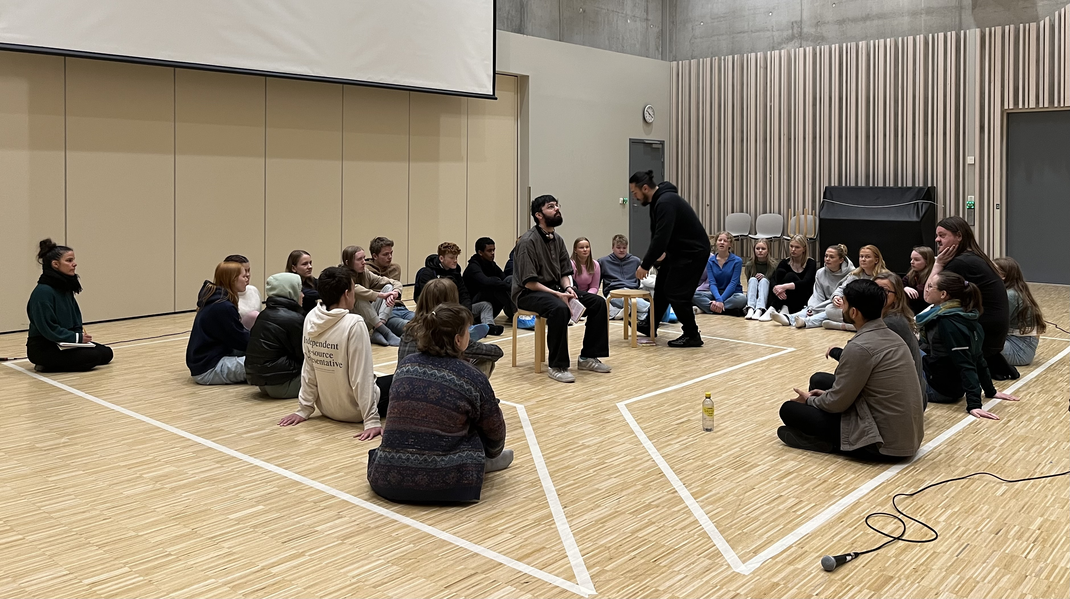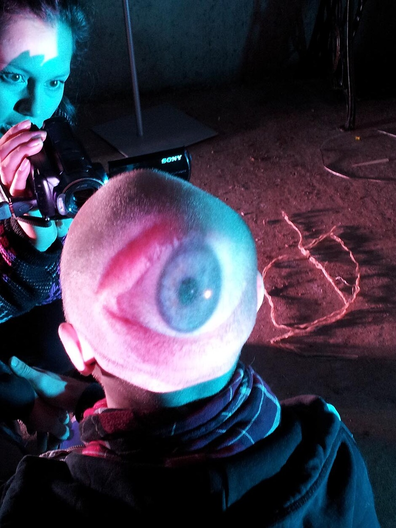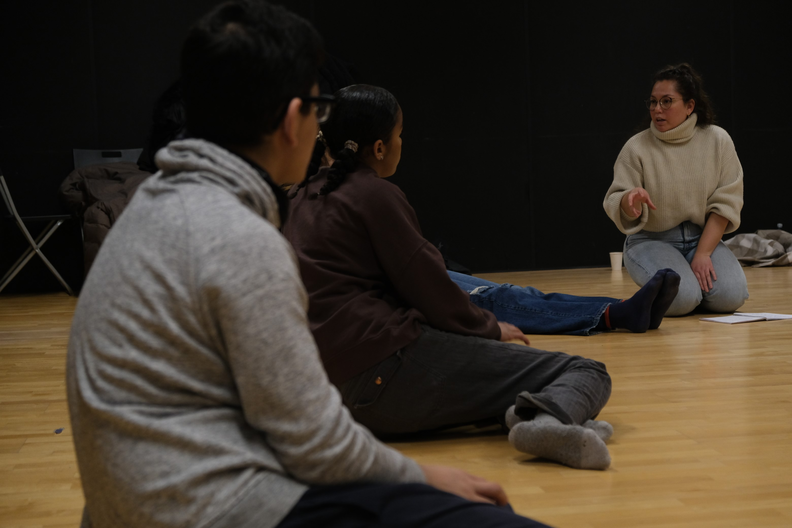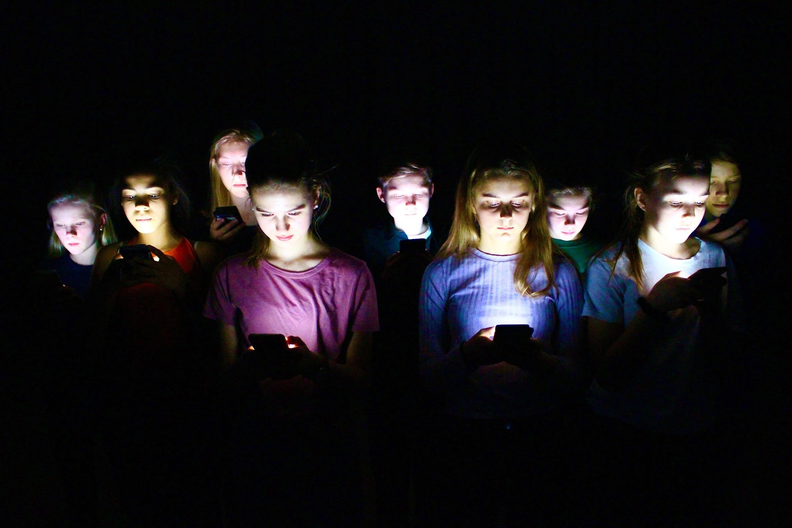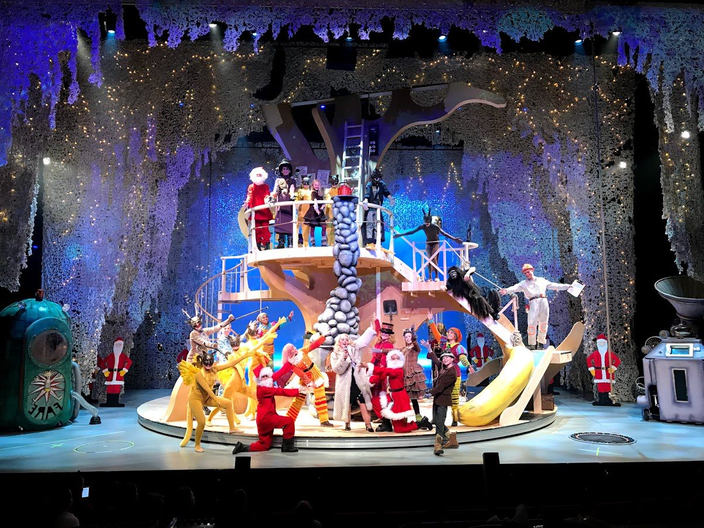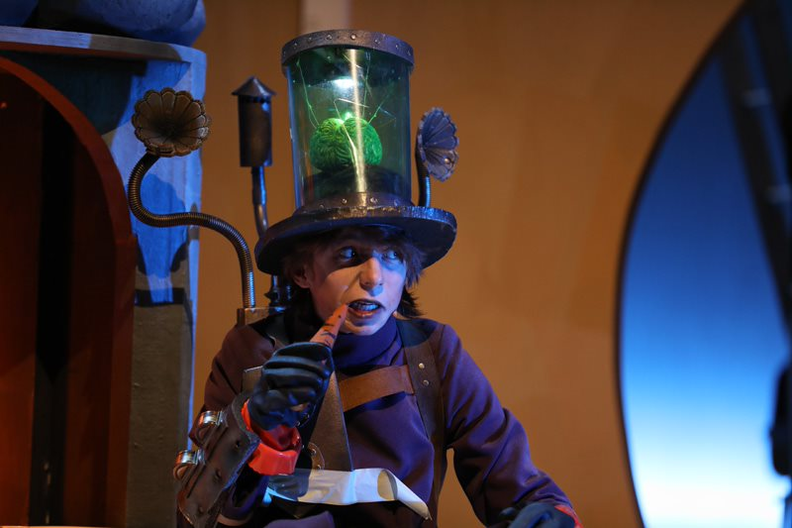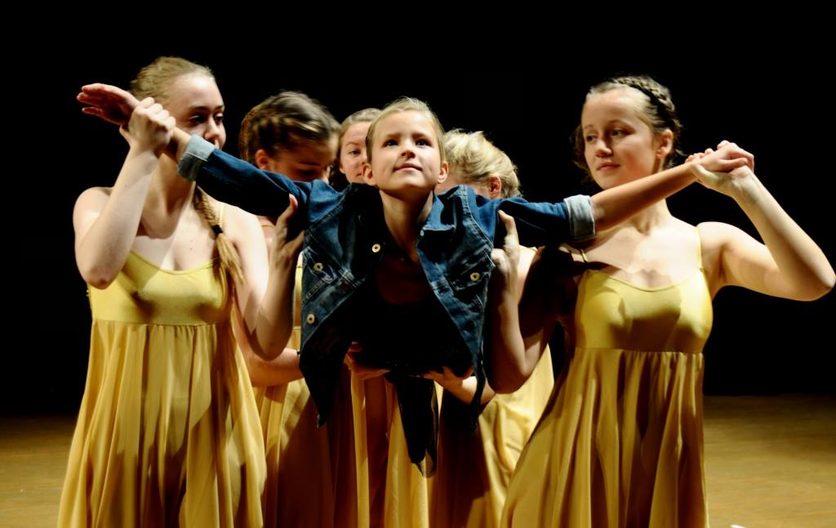1) Guro Kristin Gjøsdal, A/R/Tography in Theory and Practice in Higher Education (Stockholm University of the Arts, autumn 2023–spring 2024)
Superior research question: What can Norwegian Nynorsk contemporary drama do in a cross-aesthetic and intercultural perspective to contribute to tolerance and equality?
Research and development of The Cultural Schoolbag-production Blindsone ("Blind Spot") –Devised Hip-hop Theatre for upper secondary school.
My name is Guro Kristin Gjøsdal. I am a forty-two-year-old senior lecturer student at the National Centre for Norwegian Nynorsk in Education at Volda University College.
Keywords: A/R/Tographer (cross-aesthetic). College lecturer in drama and theatre. Arts and cultural mediator. Norwegian language and literature with an emphasis on Norwegian Nynorsk and Norwegian as a second language. Intercultural pedagogy. Health, democracy, and sustainability.
I work with research dissemination, practice-based planning and projects related to basic education and higher education, the intercultural, and The Cultural Schoolbag at the National Centre for Norwegian Nynorsk in Education at Volda University College.
Within my profession, I feel at home within the designation ART/ography (Irwin, 2013; LeBlanc & Irwin, 2019). ART/ography is a hybrid research methodology that makes it possible to research practice in education through artistic practice. The methodology provides tools to put my own educational activity in an A/R/Tographic perspective, and to be able to guide in A/R/Tographic processes.
I have experience in health and care, basic education from kindergarten to junior high, adult education for immigrants, culture school, Rudolf Steiner pedagogy, and within higher education. As a mediator, pedagogue and artist in The Centre for Norwegian Language and Literature and in The Cultural Schoolbag. I have performative experience from the free and established art and culture field with an emphasis on song/music, text, and theatre (local, national, and with international collaborations. Traditional, avant-garde, and contemporary).
My interests, education, and work experiences are interdisciplinary. This is marked by my work as an artist, researcher, and teacher. The production I outline is also interdisciplinary. What characterises interdisciplinary research is that the researcher, based on an overlapping theme, seeks insights through an agenda where a certain degree of integration takes place towards a goal with a possible transformative potential (Sæther, 2022, p. 80).
The production "Blindsone"
"Blindsone" ("Blind Spot") is an intercultural Devised Theatre-production for The Cultural Schoolbag by The Centre for Norwegian Language and Literature and the county of Møre og Romsdal, in collaboration with The National Centre for Norwegian Nynorsk in Education, Volda University College, and the performing artists Mine Nilay Yalcin, Samir Mahad and Jahanger Ali. The target group is upper secondary school.
The production is based on the award-winning novel “Eit anna blikk” (“Another look”) by Erlend Skjetne. The work is in progress with start-up in June 2022 and completion for touring in December 2023/May 2024.
This research project uses the potential of contemporary Norwegian Nynorsk drama/literature and Devised Theatre as methods in the development of a scenic production in The Cultural Schoolbag. The production has purposes within the Norwegian language, aesthetic learning processes and intercultural pedagogy.
Guide through the exhibition
1) About me as an A/R/Tographer and student
AUTUMN 2023–A/R/Tography in Theory:
2) The challenge
3) Let's meet the inspirer and A/R/Tographer Christine Yangco Helland!
4) Health and Ethics as A/R/Tographer
5) Summary in dialogue with literature
6) References
SPRING 2024–A/R/Tography in Practice
7) ...
8) ...
* The nature pictures and films are taken from my own country house/home town. Living in the district with responsibility and care for children alone, has, with the perspective of the methodology, become a resource for theoretical understanding and project development. Be present - create ripples in the water.
2) Handling the challenge
My challenge is to research and develop The Cultural Schoolbag-production "Blindsone" with A/R/Tography as a methodology, from idea to finished production for touring. It is also to produce new knowledge:
Interdisciplinary practice as an ART/ographer. Cooperation. Contribute knowledge, facilitate equal cooperation and commitment.
In this exhibition, focus on theory and knowledge sharing and understanding within the methodology. I have interviewed an A/R/Tograph whom I am professionally inspired by. Her name is Christine Yangco Helland. I have explored how she carries out her entangled practice as artist/researcher/teacher. The interview uses the self-selected article Dewey Through A/r/tography (Siegesmund, 2012), and relevant compulsory course literature as theory to think with.
3) Let's meet A/R/Tograph Christine Yangco Helland (OsloMet)!
Christine Yangco Helland is an educated drama teacher, director, and dramaturg, with a master’s degree in fine arts with specialisation in theatre from the University of Agder, Norway. She has worked for seven years at the Kilden Performing Arts centre, where she has, among other things, been the director of several theatre productions for children and young people. She has also worked with the talent development program Ungdomskilden, as well as the theatre group Fotspor – a group with participants from the work practice program of Kirkens Bymisjon (Buskerud Teater, 2023). Helland has been involved with Black Box Teater, Kloden Teater, Buskerud Teater, the short film “Først og sist”, and currently as a university lecturer in aesthetic subjects at OsloMet. Helland has a burning commitment to diversity and inclusion. In addition to working with professional productions, Helland is motivated by involving children and young people, non-professional, and marginalised groups. I have wanted to interview Helland because I feel that we have many common professional interests, values, and motivations. Helland is a new and exciting acquaintance for me in my professional work, in my desired professional direction, and in the TCS-production, “Blindsone” based on the novel “Eit anna blikk”, which I am currently working on.
A/R/Tography depicts three roles or identities: Artist (A), Researcher (R), Teacher (T). Following Springgay and Irwin (2008), the relationship between them is central, with “Arts” as activity and product, and “graphy” as text. Springgay and Irwin say that educators who see themselves as A/R/Tographers are those who are dedicated to learning, teaching, understanding, and interpreting within the community of learners. In this context, arts are perceived as a sensory-oriented product, understood, interpreted, or questioned, through ongoing involvement and encounters in the world. Artists therefore commit themselves through creation, transformation, and resistance. Irwin & Springgay (2008, p. xxv) call it a complex in-between space, the urge to explore draws us to the counter-identity as a researcher.
- How does this resonate with you as a professional, Christine Yangco Helland?
- Do you think your arts, teaching and research/developments projects intertwine and materialize as A/R/Tography, and if so, how?
- What qualities might A/R/Tography as a methodology add to your established arts, research, and teaching?
For me, teaching is dialogue-based. In my professional field, we largely work practically on the floor. Dialogue is also strongly present in theoretical teaching. The subject and the methodology create a desire for exploration that I recognise in the description of A/R/Tography. I approach or enter the teaching situation with my knowledge and a purpose to teach my students something. In the dialogic meeting between the student and the teaching material, I too learn something (compare LeBlanc & Irwin, 2019). This gives me impulses to explore my field of expertise further. This happens on several levels. Sometimes, I ask questions that are extremely basic and that make me reflect on my own learning path. I get a continuous refresher in my professional field. Students also bring perspectives that I have not reflected on before. It may also be that I teach topics that are quite new to me. Then, in many ways, I also explore the topic together with the students for the first time. Together, we discuss how we use the theme in a context. I also become more knowledgeable than by only reading theory. I explore my own field, and I am enriched by the student meetings and the dialogues. So, I am in a continuous development process myself. There are no cemented truths in my field. It makes us mobile.
Diverse themes enable me to explore and develop my various professions artist, researcher, and teacher, as well as my integrity within each of them. New knowledge is emerging in our field all the time, arising through the methods, different topics, and different groups each time. My task is to be a reflective, adjusting, and flexible practitioner. The dynamic is why I like my field so much. If I were to sum the first question up, I find the relationship between the professions of artist, researcher, and teacher to be dynamic. I can’t always separate them completely when I’m working. But it is, of course, all about context and position.
Art forms, teaching, research, or development projects are intertwined and materialised as A/R/Tography. You are aware of what is emphasised, and you take the experience back to the various professions. It is a dynamic shift. I am working on a project in Nordic Black Express now. Here I am both director and teacher. We work devised, meaning that we develop the production together, and I supervise and am artistically responsible. Oslo Kammerorkester is involved in this production as well. We also create music, so it’s a new method for all partners. It is a big project, and the sheer size of it is a new experience for many of us. Precisely this project, our experiences, and methods, mean that we create a new method at the same time. I am planning an article about the production, but I think the actual process and production is research and development. The process and production can be documented through film, for example. The spectator and the moment have a value in themselves. Written text, with a combination of film, photo and/or sound might be an option, but I haven’t thought much about it yet.
Helland and I talk about how extensive work is done within artistic development work and research, and how we feel suspect other fields do not understand this. Both of us have experienced carrying out large, extensive practical projects in our master’s degree, and that the academic writing is given the most weight. At the same time, we reflect on valuing being able to immerse oneself and write traditionally and academically as well. It’s all about mastering a comprehensive craft.
Do you experience that contemporary drama can make a difference in a scenic and intercultural perspective to contribute to tolerance and equality? If so, how? And are there any scientific and/or ethical perspectives that motivate you in your work? If so, how?
I feel that inter-culturalism is slowly gaining more voices. This happens because we use newly written drama, and that other voices than the established ones come to the fore. More people are seen. I am talking about representation through text and the visual. Different types of stories and languages are promoted. The field of culture must give far greater space to inter-cultural people at all levels. Who decides what is set up, why, and to whom? Who are performances directed for? Who is the target group? We need deep insight into definitions and positions. I don’t want to take the job from anyone. I want there to be more space for people from other cultures and other marginalised groups. This cannot be said too often!
I am passionate about the diversity perspective, and I want to emphasise this in my work. There can be both discouraging and constructive processes in this work. I am passionate about the potential in people, democracy, and justice. Who can we trust in the society? Can I trust myself, in the position of high school lecturer, now in the middle class? I am inter-cultural myself, and grew up with a single mother in Haugenstua, Oslo. Our economy was tight, the whole working-class package. I have spent a lot of time pretending to be Norwegian. It wasn’t that long ago I realised how indoctrinated we are as a society. I feel enormous shame for having tried to hide the inter-cultural part of me. I now understand that, sub-consciously, it has been a survival strategy that also helped me achieve my desires and goals regarding education and work. Like many, I haven’t used my foreign surname for a while. I did this with the support of my mother. But it makes me incredibly sad to understand today more of the shame that many inter-cultural people carry. And I am ashamed to have been ashamed of my cultural background. So, there are several layers of self-hate. This greatly affects an identity.
But you are a young woman. Now you can use your insight to create ripples in the water
ripples in the water
ripples in the water
ripples in the water
ripples in the water
ripples in the water.
... Contribute to developing tolerance and equality. A diverse and democratic society.
Yes, I hope so. But it is demanding. We are dealing with topics and exhange of words that I find extremely inflamed. But we live in it now. It is both an exciting and scary discord. I can feel alone in that kind of work. To meet you, who is in another geographically place, gives me hope, community, and comfort. Knowing that there are more people sitting and working with this value base and these intentions.
Theatre is also a science. I am passionate about the theatre profession acting, directing, teaching, and so on and work close to and with people. The science also feels inter-disciplinary, as we touch on cross-aesthetic disciplines, psychology, sociology, and history, for example. As I’m teaching others, I’m learning myself, too. It is a field that keeps me in constant learning. No two project are the same. And the combination of people is different. This means that I am constantly adapting and developing. And so does my subjects. My field and I do this together, in a way.
The starting point is that theatre is so much fun! I love being in the energy on stage, and I want to give this joy to other people. I’m a nerd, and I become even more nerdy when I incorporate research in my work, too. That’s why I like A/R/Tography. I am so curious about the methodology. It is these three identities I am dwelling on. And the tension field between them. It is a separate knowledge and specialty to be both a specialist and a generalist. We humans have so much potential to play on. We are not just one or the other.
I think that A/R/Tography for me is a basic curiosity about other people, especially with an emphasis on teaching. To create together. … the relational. I can sometimes think that I don’t need the show. The job is done, in a way. The magic happens in the process. This is where we learn the most important stuff. Understand me correctly; the performance is also important. We can talk a lot about that.
In the myriad of teaching, administration, and New Public Management, we must remember the intention. I must begin with myself. It is about feeling the spark of life, hope, and meaning. It may sound naïve and idealistic, but this is my motivation. The big themes I am working on will probably not be solved in my lifetime. But I want to contribute, and to bring it further.
I also think about having gone on a class trip. Now, I belong to the middle class and must be aware of the role in my position. I have always felt like an underdog, without really understanding it. And then one is no longer that but is also unable to identify with the white middle class. Then I fight the case of the underdog from a new position. I am afraid of being a “white saviour”.
It’s about using the position to your advantage. One can feel powerless. For what can be done in the big picture? I try to stay focused. You can lose a lot of power by taking in how bad the world is in many ways. In my profession, I can help influence the curriculum, for example. This means that the students will not only receive Western European literature, and that voices from outside will be included in the teaching. Working for tolerance, equality and diversity is something that must always be done continuously at all levels. Diversity must be rooted, not just checked off a list.
4) Health and Ethics as A/R/Tograph
An ethical perspective I would like to highlight is taking care of oneself as an A/R/Tograph, which is a comprehensive role. To burn out is common in our profession. And with the set of values and the intention I work with, one can be overwhelmed and discouraged by the corrupt.
I’m used to thinking about the people I work with, and not so much about myself. But this is a new perspective that I am integrating.
Helland shares her 10 best tips for health and ethics as an A/R/Tograph:
1) Set boundaries and prioritise in the calendar.
2) Schedule a home office whenever possible, so as not to be disturbed. Take time off when possible.
3) Do not respond to e-mails after work and on weekends (unless there is something specific that is urgent).
4) Do not have students as friends in social media.
5) Protect my private life and separate it from my work-life.
6) Spend time with friends in a safe space. This gives energy and well-being.
7) Walk, exercise, do yoga, practice mindfulness, sing in a choir, and follow other recommendations from my doctor.
8) Be able to distance myself from work, news, etc.
9) Correspond by e-mail and not Messenger/chat.
10) Fewer and more efficient meetings.
5) A summary in dialogue with Dewey through A/R/Tography, and other relevant literature
I experience Helland’s work as A/R/Tographic as it explores specifically the entangled position of artist/researcher/teacher, and what her art education practise set in motion to do (Irwin, 2012) for tolerance and equality. A/R/Tography’s conceptual framework is postmodern (Siegesmund, 2012; Østern, Jusslin, Knudsen, Maapalo, & Bjørkøy, 2021), and can also be seen in the context of John Dewey’s Art As Experience (Siegesmund, 2012; Dewey, 2005).
John Dewey (1859—1952) was an American philosopher, educator, and psychologist. He has had a great impact on educational development in America, European and Asian countries. Richard Siegesmund is professor emeritus of art and design education in Northern Illinois University, USA. Siegesmund’s essay Dewey Through A/r/tography (2012) argues for the relevancy of Art as Experience (2005) to A/R/Tography. The structure of Siegesmund's essay follows the lines of argument within Dewey’s first three chapters: “The Live Creature,” “Ethereal Things,” and “Having an Experience.” These chapters offer significant insight into the close links Dewey saw between science, aesthetics, and inquiry, and help to show how A/R/Tography not only resonates with Dewey’s aesthetics, but to other significant traditions within Western thought as well.
Dewey argued for aesthetic experiences—in our daily lives and in art making—as forms of inquiry (Siegesmund, 2012). While Dewey acknowledged that the arts and social sciences serve different purposes, both science and aesthetics require dynamic organization. In this sense, art-based social science research is not an oxymoron. There is a point in attempting a marriage of the two, but this requires both humility toward what we empirically grasp and rigor to push deeper into our ethereal troubling.
Siegesmund (2012) teaches me that inquiry is not a series of steps that draws us nearer to the distance. Inquiry is a process of constructing a point of transition. It is an effort toward making a border crossing. Through the compression of experience, in our reflective undergoing, we forge this entryway. The hope of inquiry is that it may be possible to step through this portal, stand in an arc of time, and behold a possible future that synthesizes our past. This is a measure for the success of research.
Siegesmund (2012) experience that the history of ideas is not linear; we are always circling back to points of origin. Reconsidering pathways and alternatives routes for empirical investigation into the world is an important theme of Art as Experience. As such, the article is a harbinger for arts-based research. Through A/R/Tography, Siegesmund says that we can see how Art as Experience is an underappreciated work. Through the lens of A/R/Tography, me as an educational researcher discover it anew in my work, production, study, and argumentation for the methodology.
I perceive that Helland’s work also is A/R/Tographic in that it particularly explores the intertwined position of the artist/researcher/teacher by 1) giving a robust sense of the complexity and fulness of the relationship between arts, researching and teaching, and that this is central to deep understanding of the possibilities within the methodology, 2) A/R/Tography extends the opportunities and dilemmas to our approach to the conduct of research, and 3) brings out life and relationship, the wisdom in artistic practice, and the desire and subjectivity in research.
The methodology submits new thinking in the relationship between the quality’s arts—research—teaching in Christine Yangco Helland’s work. Helland is grateful and happy to gain some insight into the A/R/Tography methodology through my interview request. This is a methodology she feels at home in, and we will keep in touch and collaborate.
6) References
Bjørnstad, G. B., & Ellinggard, S. N. (red.) (2023). Performative innganger til undervisning. Perspektiver på skapende læring med tverrfaglige tema. Universitetsforlaget, NO.
Dewey, J. (2005). Art As Experience. Perigee Books, U.S.
Gjøsdal, G. K. (2023, December 5). Kvifor nynorsk i Den kulturelle skulesekken? Obtained from https://periskop.no/kvifor-nynorsk-i-den-kulturelle-skulesekken/
Irwin, R. L. (2013). Becoming A/R/Tography. Studies in Art Education, 54(3), 198–215. https://doi.org/10.1080/00393541.2013.11518894
Irwin, R. L., & Springgay, S. (2008). A/r/tography as practice-based research. In S. Springgay, R. L. Irwin, C. Leggo, & P. Gouzouasis (Eds.), Being with a/r/tography. Rotterdam, The Netherlands: Sense.
LeBlanc, N., & Irwin, R. (2019). A/R/Tography. In G. Noblit (Ed.). Oxford Encyclopedia of Qualitative Research Methods in Education (21 s.). Oxford University Press.
Siegesmund, R. (2012). Dewey Through A/r/tography. Visual Arts Research, 38(2), 99–109. https://doi.org/10.5406/visuartsrese.38.2.0099
Sæther, K.-W. (2022). Når forskningskulturer møtes: Noen prinsipielle avklaringer av interdisiplinær forskning. In H. V. Kleive, J. G. Lillebø, & K.-W. Sæther (Eds.), Møter og mangfold: Religion og kultur i historie, samtid og skole (pp. 61–82).
Østern, T. P., Jusslin, S., Knudsen, K. N., Maapalo, P., & Bjørkøy, I. (2021). A performative paradigm for post-qualitative iquiry. Qualitaty Research. 23(2), 272-289. http://journals.sagepub.com/doi/10.1177/14687941211027444
